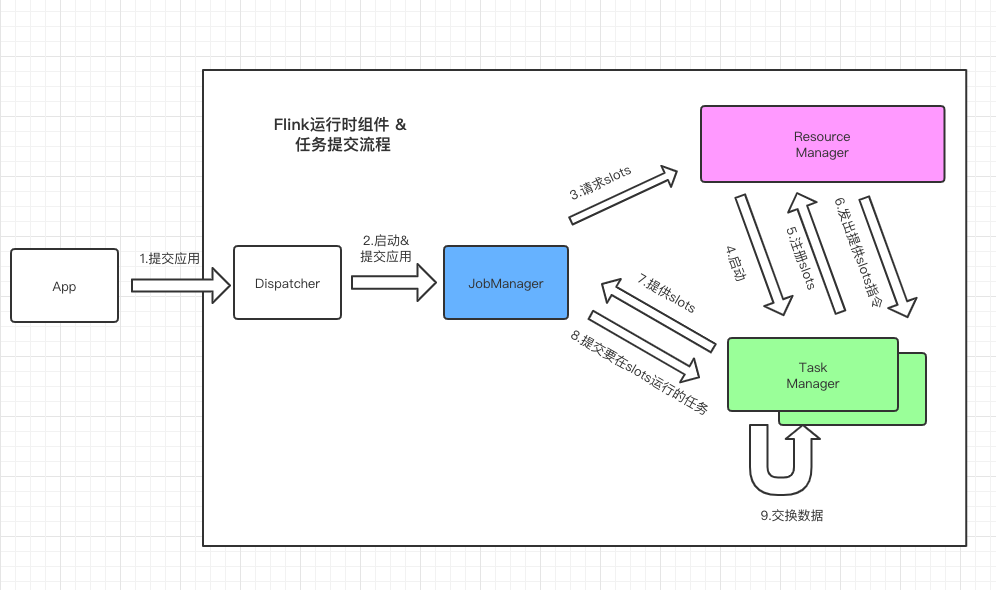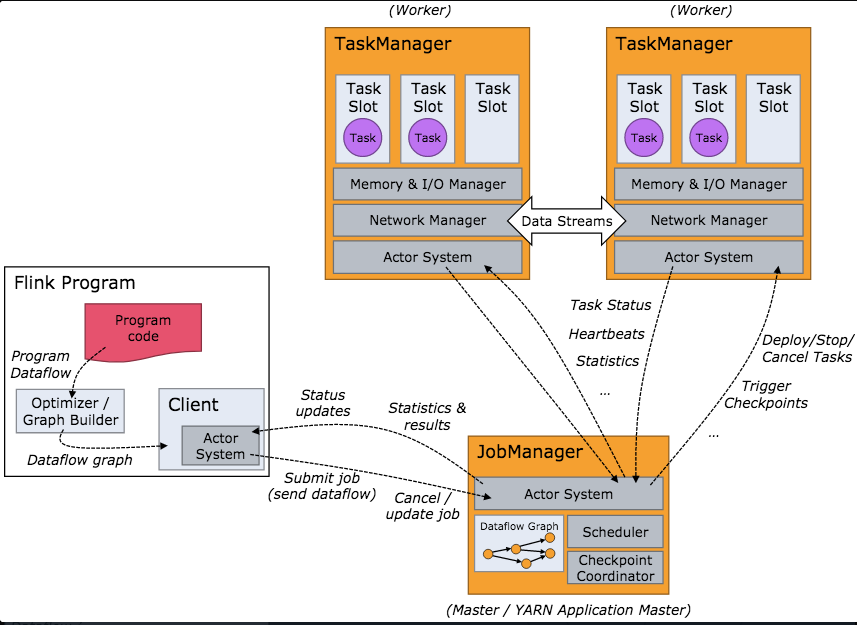Flink(三) —— 运行架构
Flink运行时组件
- JobManager 作业管理器
- TaskManager 任务管理器
- ResourceManager 资源管理器
- Dispatcher 分发器
任务提交流程

任务调度原理
Job Managers, Task Managers, Clients
The Flink runtime consists of two types of processes:
The JobManagers (also called masters) coordinate the distributed execution. They schedule tasks, coordinate checkpoints, coordinate recovery on failures, etc.
There is always at least one Job Manager. A high-availability setup will have multiple JobManagers, one of which one is always the leader, and the others are standby.
The TaskManagers (also called workers) execute the tasks (or more specifically, the subtasks) of a dataflow, and buffer and exchange the data streams.
There must always be at least one TaskManager.
The JobManagers and TaskManagers can be started in various ways: directly on the machines as a standalone cluster, in containers, or managed by resource frameworks like YARN or Mesos. TaskManagers connect to JobManagers, announcing themselves as available, and are assigned work.
The client is not part of the runtime and program execution, but is used to prepare and send a dataflow to the JobManager. After that, the client can disconnect, or stay connected to receive progress reports. The client runs either as part of the Java/Scala program that triggers the execution, or in the command line process ./bin/flink run ....

Task Slots and Resources
Each worker (TaskManager) is a JVM process, and may execute one or more subtasks in separate threads. To control how many tasks a worker accepts, a worker has so called task slots (at least one).
每个TaskManager都是一个JVM进程,可以在独立的线程中执行一个或多个子任务。TaskManager有Task Slots来控制可以接收多少个任务(一个TaskManager至少有一个Task Slot)。
Each task slot represents a fixed subset of resources of the TaskManager. A TaskManager with three slots, for example, will dedicate 1/3 of its managed memory to each slot. Slotting the resources means that a subtask will not compete with subtasks from other jobs for managed memory, but instead has a certain amount of reserved managed memory. Note that no CPU isolation happens here; currently slots only separate the managed memory of tasks.
By adjusting the number of task slots, users can define how subtasks are isolated from each other. Having one slot per TaskManager means each task group runs in a separate JVM (which can be started in a separate container, for example). Having multiple slots means more subtasks share the same JVM. Tasks in the same JVM share TCP connections (via multiplexing) and heartbeat messages. They may also share data sets and data structures, thus reducing the per-task overhead.

参考文档
Flink Distributed Runtime Environment
Flink(三) —— 运行架构的更多相关文章
- Flink 的运行架构详细剖析
1. Flink 程序结构 Flink 程序的基本构建块是流和转换(请注意,Flink 的 DataSet API 中使用的 DataSet 也是内部流 ).从概念上讲,流是(可能永无止境的)数据记录 ...
- Flink| 运行架构
1. Flink运行时组件 作业管理器(JobManager) 任务管理器(TaskManager) 资源管理器(ResourceManager) 分发器(Dispatcher) 2. 任务提交流程 ...
- hadoop记录-[Flink]Flink三种运行模式安装部署以及实现WordCount(转载)
[Flink]Flink三种运行模式安装部署以及实现WordCount 前言 Flink三种运行方式:Local.Standalone.On Yarn.成功部署后分别用Scala和Java实现word ...
- 01-Flink运行架构
1.flink运行时的组件 Flink 运行时架构主要包括四个不同的组件,它们会在运行流处理应用程序时协同工作: 作业管理器(JobManager).资源管理器(ResourceManager). ...
- Flink(二)【架构原理,组件,提交流程】
目录 一.运行架构 1.架构 2.组件 二.核心概念 TaskManager . Slots Parallelism(并行度) Task .Subtask Operator Chains(任务链) E ...
- Spark入门实战系列--4.Spark运行架构
[注]该系列文章以及使用到安装包/测试数据 可以在<倾情大奉送--Spark入门实战系列>获取 1. Spark运行架构 1.1 术语定义 lApplication:Spark Appli ...
- 【转载】Spark运行架构
1. Spark运行架构 1.1 术语定义 lApplication:Spark Application的概念和Hadoop MapReduce中的类似,指的是用户编写的Spark应用程序,包含了一个 ...
- Apache Flink 分布式运行时环境
Tasks and Operator Chains(任务及操作链) 在分布式环境下,Flink将操作的子任务链在一起组成一个任务,每一个任务在一个线程中执行.将操作链在一起是一个不错的优化:它减少了线 ...
- 朱晔的互联网架构实践心得S1E8:三十种架构设计模式(下)
朱晔的互联网架构实践心得S1E8:三十种架构设计模式(下) [下载本文PDF进行阅读] 接上文,继续剩下的15个模式. 数据管理模式 16.分片模式:将数据存储区划分为一组水平分区或分片 一直有一个说 ...
- spark 运行架构
spark 运行架构基本由三部分组成,包括SparkContext(驱动程序),ClusterManager(集群资源管理器)和Executor(任务执行过程)组成. 其中SparkContext负责 ...
随机推荐
- java内存模型一
Java平台自动集成了线程以及多处理器技术,这种集成程度比Java以前诞生的计算机语言要厉害很多,该语言针对多种异构平台的平台独立性而使用的多线程技术支持也是具有开拓性的一面,有时候在开发Java同步 ...
- dfs第二遍重学
---恢复内容开始--- 1.先上个基础的全排列 #include<iostream> #include<cstring> using namespace std; const ...
- Java基础之IO流整理
Java基础之IO流 Java IO流使用装饰器设计模式,因此如果不能理清其中的关系的话很容易把各种流搞混,此文将简单的几个流进行梳理,后序遇见新的流会继续更新(本文下方还附有xmind文件链接) 抽 ...
- Tensorflow学习教程------变量
#coding:utf-8 import tensorflow as tf x = tf.Variable([1,2]) a = tf.constant([3,3]) #增加一个减法op sub = ...
- HTML超链接实例介绍
<html><head><title>第六节课</title><meta charset="UTF-8"></he ...
- docker入门2---docker的初体验
Tomxin7 Simple, Interesting | 简单,有趣 第一个Docker镜像? 尝试运行docker自带的镜像"hello-world",了解docker镜像的下 ...
- (递归)P1036 选数
#include<stdio.h>#include<math.h>int x[20],n,k,i; //判断是否质数 int isprime(int n){ for(i= ...
- windows和ubuntu双系统设置开机默认系统
1.记住grub界面中windows的位置 我的界面如下:windows在第3行 2.选择进入ubuntu系统 3.打开终端,输入如下命令 sudo vim /etc/default/grub 4.看 ...
- 深度学习在美团配送ETA预估中的探索与实践
1.背景 ETA(Estimated Time of Arrival,“预计送达时间”),即用户下单后,配送人员在多长时间内将外卖送达到用户手中.送达时间预测的结果,将会以”预计送达时间”的形式,展现 ...
- Spring Bean的生命周期、Spring MVC的工作流程、IOC,AOP
1.Spring Bean的生命周期? (1)构造方法实例化bean. (2)构造方法设置对象属性. (3)是否实现aware接口,三种接口(BeanNameAware,BeanFactoryAwar ...
